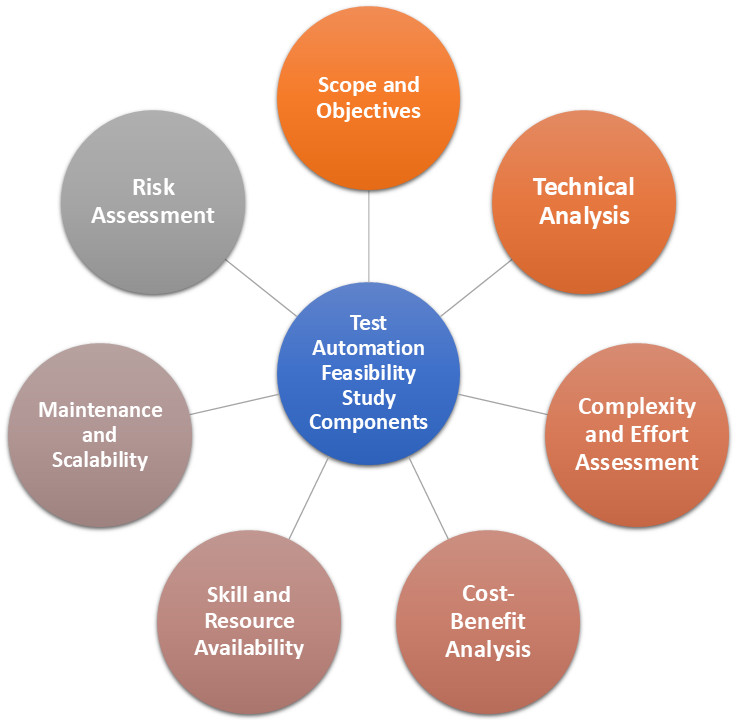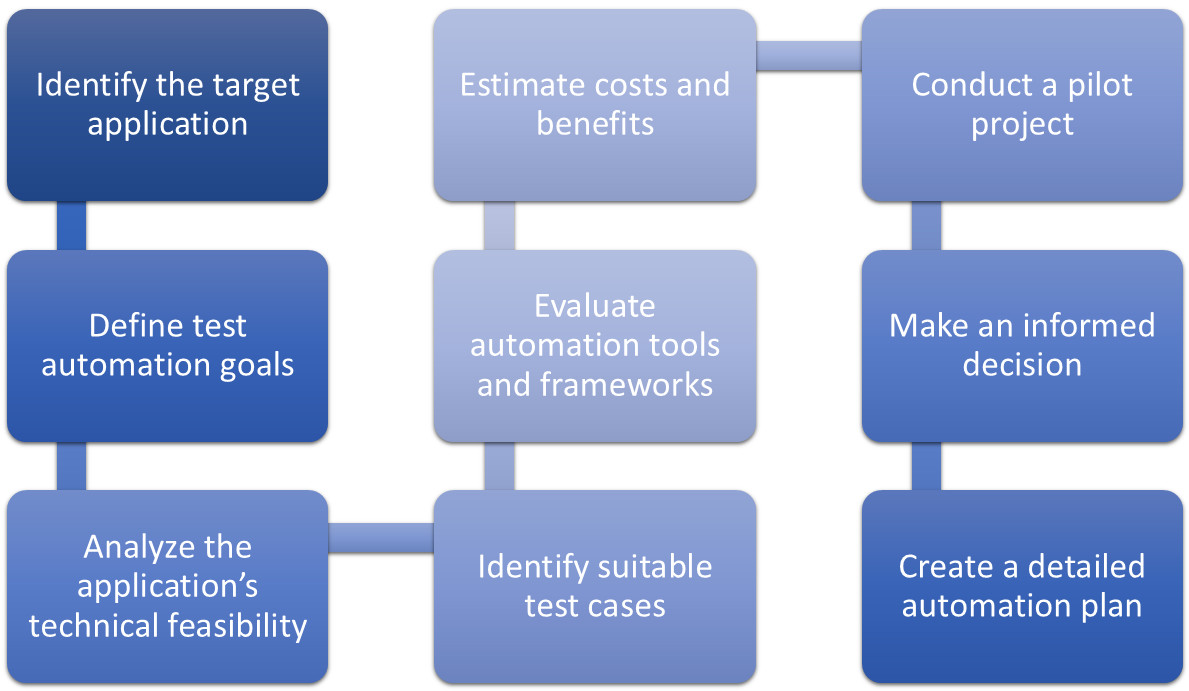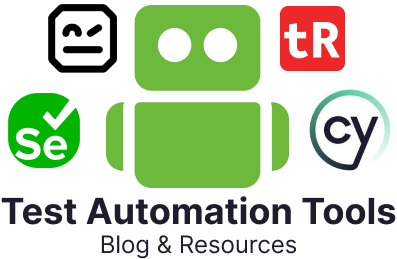Imagine a mid-sized tech company that is eager to accelerate its software releases. The development team decides to implement test automation to cut down on the time spent on repetitive manual tests. Excited by the potential speed gains they jump headfirst into automating their regression suite.
But soon, problems start surfacing. Automated tests are flaking out due to frequent changes in the user interface, the team realizes they don’t have the skills to maintain the scripts effectively, and the promised time savings turn into long hours of fixing broken tests. Ultimately, the project stalls and manual testing takes over once more.
This scenario is not uncommon. It underscores the importance of a test automation feasibility study, a crucial yet often overlooked step that can prevent costly missteps and set teams on a path to successful automation.
In this blog, we’ll explore how to conduct a test automation feasibility study and the key components and practical steps to ensure your team is set up for success.
What is Test Automation Feasibility?
A test automation feasibility analysis examines the practicality and potential return on automating specific tests in a project. This step ensures that teams make informed decisions by weighing the benefits against the costs and challenges.
Components of Test Automation Feasibility
Components of a test automation feasibility study include various aspects that help evaluate the practicality, benefits, and challenges of implementing test automation. These components are also what one looks at when doing a feasibility study.
Here’s a breakdown of these essential components:
Scope and objectives
The primary objective is to determine if test automation is a strategic fit for the project.
- Defining the scope: Identify which test cases should be automated. These may include repetitive, time-consuming, or critical tests that need to be run frequently.
- Setting objectives: Outline the goals of automation, such as reducing manual effort, improving test coverage, enhancing reliability or speeding up the testing process.
Technical analysis
The study assesses the application under test to determine if it is suitable for automation.
- Application Under Test (AUT) assessment: Evaluate the application’s technology stack and determine whether it is compatible with automation tools. Check for factors such as stable identifiers for UI elements and low dynamic content that may impact automation.
- Tool and framework evaluation: Identify which automation tools and frameworks are suitable for the project based on compatibility with the AUT, project budget, and team expertise.
Complexity and effort assessment
This step involves identifying the level of effort required to automate test cases.
- Test case complexity analysis: Classify test cases based on their complexity (e.g., simple, medium or complex) and assess their feasibility for automation.
- Effort estimation: Estimate the time and resources required for creating, running, and maintaining automation scripts. For example, straightforward, repetitive tests might be easy to automate, while complex or dynamic test cases may pose significant challenges.
Cost-benefit analysis
The feasibility study includes a financial assessment to determine whether the expected benefits of test automation (e.g., reduced manual effort faster release cycles) outweigh the initial and ongoing costs of implementing and maintaining the automation.
- Initial costs: Consider costs such as tool licenses, initial development, and training.
- Ongoing costs: Factor in maintenance and update efforts.
- Benefits assessment: Analyze potential savings in time and resources, improved accuracy, and faster feedback loops.
- ROI calculation: Compare costs to potential benefits to determine if automation is a worthwhile investment.
Skill and resource availability
The study evaluates the existing skill levels within the team and determines if they are sufficient for building and maintaining automation or if training and additional resources are needed.
- Team expertise: Assess whether the team has the necessary skills for test automation or if additional training or new hires are required.
- Resource allocation: Determine if the necessary resources (e.g., hardware, software, environment) are available to support automation.
Maintenance and scalability
This aspect focuses on understanding the long-term sustainability of the automation solution.
- Sustainability of automation: Assess the ease with which the automation scripts can be maintained over time, especially if the application undergoes frequent updates.
- Scalability considerations: Ensure that the chosen automation solution can be scaled up as the project grows or as new test cases are added.
Risk assessment
The study identifies risks and outlines potential mitigation strategies.
- Identifying risks: Identify potential risks such as test flakiness, tool limitations, integration issues, and compatibility problems.
- Mitigation strategies: Develop strategies to manage and mitigate these risks, such as setting up proper monitoring and maintenance processes or choosing robust tools that align with project needs.

Test Automation Feasibility in SDLC
A test automation feasibility study fits into the early stages of the test automation lifecycle or the software development lifecycle (SDLC). It acts as a foundational step that helps set the stage for subsequent phases. You want to do this activity first so that you can
- Identify and mitigate potential risks and challenges early on
- Allocate resources effectively
- Gain necessary insights to make project-related decisions
Importance of Test Automation Feasibility
Without a feasibility study, teams may jump into automation without fully understanding the implications, which will lead to wasted time, money, and effort. A well-executed feasibility study helps teams avoid these pitfalls by providing a clear roadmap and setting realistic expectations for what can be achieved with test automation. It also ensures that teams are prepared for the challenges ahead and have a solid plan for addressing them. This results in a more strategic and successful approach to test automation.
Guide for Test Automation Feasibility
Now, let’s talk about how to conduct a feasibility study for test automation. You need to check whether the components, which also happen to be parameters for checking feasibility, are satisfied or not.
Here’s a step-by-step guide that you can use to do a test automation feasibility study.
Step 1: Identify the target application
- Clearly define the software application or system to be automated.
- Understand its core functionalities, user interface, and technology stack.
Step 2: Define test automation goals
- Determine the specific objectives of automation, such as:
- Reducing test execution time
- Increasing test coverage
- Improving test accuracy
- Enhancing test reliability
Step 3: Analyze the application’s technical feasibility
- Stability: Assess the application’s stability and frequency of changes.
- Object identification: Evaluate the ease of identifying and locating UI elements using automation tools.
- Technology compatibility: Determine the suitability of automation tools for the technology stack (e.g., web, mobile, desktop).
Step 4: Identify suitable test cases
- Select test cases that are repetitive, time-consuming, and prone to human error.
- Prioritize test cases based on their criticality and potential for automation.
Step 5: Evaluate automation tools and frameworks
- Research and evaluate various automation tools and frameworks based on:
- Ease of use
- Functionality
- Community support
- Licensing costs
- Integration capabilities
- Consider tools that can integrate with your existing ecosystem and offer one-stop solutions. You can even explore AI-based tools that allow you to write test cases in plain natural language. This cuts down the investment of coding test cases as test scripts in another programming language or hiring specialists to do this. Your in-house QA team is all you will need.
Step 6: Estimate costs and benefits
- Initial investment: Calculate the costs of purchasing licenses, setting up infrastructure, and training team members.
- Ongoing maintenance: Estimate the cost of maintaining and updating automation scripts.
- Time savings: Calculate the potential reduction in test execution time.
- Increased test coverage: Assess the potential to increase test coverage.
- Improved accuracy: Estimate the reduction in human error and the improvement in test accuracy.
Step 7: Conduct a pilot project
- Select a small subset of test cases to automate as a proof of concept.
- Implement automation using the chosen tools and frameworks.
- Evaluate the effectiveness of the pilot project and identify lessons learned.
Step 8: Make an informed decision
- Based on the findings of the feasibility study and pilot project, make a decision on whether to proceed with full-scale automation.
- Consider factors like the potential ROI, technical feasibility, and the team’s expertise.
Step 9: Create a detailed automation plan
- Define the scope, timeline, and resource requirements for the automation project.
- Identify the automation framework and tools to be used.
- Develop a test automation strategy, including test case selection, script development, and execution.
Step 10: Implement and maintain automation
- Develop and execute automation scripts.
- Integrate automation into the CI/CD pipeline.
- Continuously maintain and update automation scripts to adapt to changes in the application.

Conclusion
A feasibility study is an excellent way to ensure you invest your resources effectively and efficiently. Teams can evaluate the practicality, benefits, and challenges of automating specific tests in advance and make informed decisions. This will help you ensure that the investment in test automation yields significant returns.

